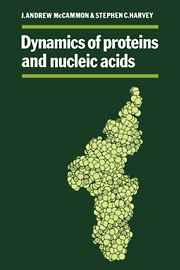Book contents
- Frontmatter
- Contents
- Preface
- 1 Introduction
- 2 Structure of proteins, nucleic acids, and their solvent surroundings
- 3 Dynamics of proteins, nucleic acids, and their solvent surroundings
- 4 Theoretical methods
- 5 Short time dynamics
- 6 Local structural transitions
- 7 Global structural changes
- 8 Dynamics of molecular associations
- 9 Recent developments and future directions
- Appendix 1 Numerical integration of the equations of motion
- Appendix 2 Detailed description of computer programs and procedures for energy minimization and molecular dynamics
- Appendix 3 Molecular dynamics at constant temperature and pressure
- References
- Index
1 - Introduction
Published online by Cambridge University Press: 05 June 2012
- Frontmatter
- Contents
- Preface
- 1 Introduction
- 2 Structure of proteins, nucleic acids, and their solvent surroundings
- 3 Dynamics of proteins, nucleic acids, and their solvent surroundings
- 4 Theoretical methods
- 5 Short time dynamics
- 6 Local structural transitions
- 7 Global structural changes
- 8 Dynamics of molecular associations
- 9 Recent developments and future directions
- Appendix 1 Numerical integration of the equations of motion
- Appendix 2 Detailed description of computer programs and procedures for energy minimization and molecular dynamics
- Appendix 3 Molecular dynamics at constant temperature and pressure
- References
- Index
Summary
Function of proteins and nucleic acids
Proteins and nucleic acids are particularly prominent among the molecules essential to life. Their importance stems from the remarkable diversity of their functional roles. This diversity can be illustrated by listing a few of the major groups within each of these molecular families. Proteins are molecules that act to build the structural elements of organisms and to provide the energy necessary for life processes. Enzymes are proteins that catalyze biochemical reactions. Familiar examples include the digestive enzymes that degrade foodstuffs to simple, assimilable compounds; the biosynthetic enzymes that build complex molecules from simpler compounds; and muscle proteins that produce mechanical work from chemical reactions. Transport proteins such as hemoglobin facilitate the movement of molecular oxygen and other essential compounds to their sites of utilization. Antibodies are proteins that bind to and neutralize foreign materials that may be harmful to an organism. Other proteins are responsible for maintaining the structures of cells, organs, and organisms, while still others play essential roles in genetic expression, nerve conduction, and all other biological processes. Nucleic acids are the molecules that carry the information necessary for protein synthesis; they can be considered the ‘blueprints’ that contain the design of the living organism. In both procaryotes and eucaryotes, the genetic information of heredity is carried from one generation to the next in DNA, while various types of RNA's play vital roles in the translation of the DNA sequence of each gene into the amino acid sequence of the corresponding protein.
- Type
- Chapter
- Information
- Dynamics of Proteins and Nucleic Acids , pp. 1 - 5Publisher: Cambridge University PressPrint publication year: 1987
- 2
- Cited by

